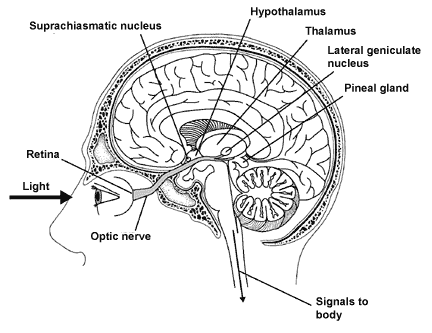
National Institutes of Health
The biological clock is located within the suprachiasmatic nucleus in the brain, and is affected by light, as is the pineal gland. Note the near direct pathway along the optic nerve from the eyes to these structures in the brain.
The crucial role circadian rhythms, the biological clock, and light have for sleep functioning is confirmed by the experience of those with blindness. Most persons who are completely blind suffer from insomnia to some degree, because they cannot distinguish day from night. With some exceptions, their biological clocks cannot be reset by sunlight or any form of bright light for that matter. Blind persons are sometimes treated with doses of artificial melatonin to help regulate their natural circadian rhythms.
Although the exact function of melatonin in humans is not completely clear, this substance is sometimes prescribed for circadian rhythm disorders and as a “natural” treatment for insomnia, although evidence for its effectiveness in those with normal eyesight is inconclusive.
Our biological clocks change as we age
Ideally, our biological clock is synchronized closely to the daily 24-hour cycle of the sun. The reality is not that simple.
One factor is the constantly changing length of day and night throughout the year. Depending on your latitude and the season, there are wide variations in the amount of darkness or sunlight you experience each day, and the duration of daylight typically changes by several minutes for each successive 24-hour cycle. To compensate, our built-in clock constantly adjusts to the changing of the seasons, a process known as entrainment.
Another factor is normal human physiology. From about age 14 to 30, it's common for our biological clock to slow down significantly from a normal 24-hour circadian cycle. Adolescents and young adults may experience more of a 26 to 30 hour day. So for this age group, when 11 p.m. rolls around it may feel more like 7 or 8 p.m. This is why it’s common for a teenager to be wide awake at a normal bedtime. And when it's time to get up at 7 a.m., it may feel more like 3 or 4 in the morning. Hard to get up that early!
Fortunately, by about age 30 most of our biological clocks speed back up to a more normal 24-hour cycle.
Later in life, the biological clocks of some (not all) of us continue to speed up faster than a 24-hour cycle. So this is why 8 p.m. may feel more like 11 p.m. for someone in their 70s , and 4 a.m. may feel more like 7 a.m.
Another possible factor has to do with the gradual aging of the eye. The normal yellowing of the lens and the narrowing of the pupil that occur with age can potentially disturb the body’s circadian rhythm. To help produce better sleep, this condition can be countered by deliberate exposure to indirect sunlight.
Regardless of your age, one way to maintain or recalibrate your biological clock back to normal is to use a consistent wake-up time each day, every day without exception, as much as possible. Then upon awakening immediately expose yourself to light, preferably daylight. This consistency supports better sleep, and we will explain it in much more detail in the Sleep Timing and Sleep Hygiene sections.
Artificial lighting affects sleep
Human beings have today a unique technological advantage to adjust for the role of sunlight in natural circadian rhythms. Since the advent of widespread electrical utilities and the development of artificial lighting within the last century or so, we can today with the simple flick of a switch turn night into day within our living spaces. The control of abundant artificial light allows us to have a much greater ability to choose when we sleep, and when we stay awake.
Prior to the advent of widespread artificial lighting, at night people were completely dependent on the flames of relatively dim candles, lamps, and lanterns, and as a result were far more attuned to the cycles of the sun.
Today we are less dependent on sun-to-sun lighting cycles, although many scientific studies have shown people are still genetically hard-wired and exquisitely attuned to the natural cycles of day-and-night throughout the seasons.
Nevertheless, we can exert far more control on our periods of sleep and wakefulness than could previous generations.
The ability to easily control sleep periods, by itself, can cause problems if any of a multitude of distractions crop up to interfere with sleep. However, the ability to control also creates powerful opportunities to address those distractions.
In the STS you will soon leverage these powerful opportunities to control – by learning how to create an optimal environment for restful, quality sleep.